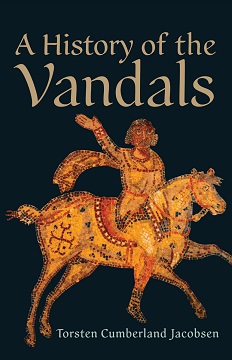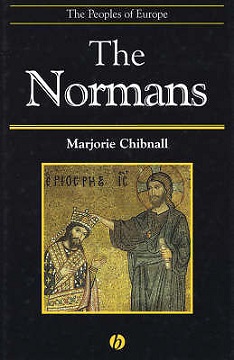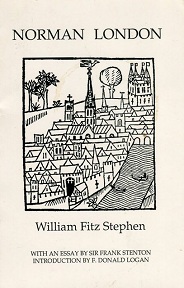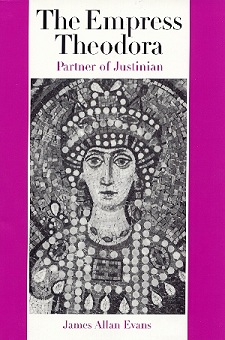
A History of the Vandals
Torsten Cumberland Jacobsen
360 pages, including index
published in 2012
Of all the Germanic tribes invading the Roman Empire, the Vandals have the worst reputation for reasons that have little to do with what they actually did. Mostly this is of course due to the simple fact that they lent their name to vandalism, coined in the wake of the French Revolution to describe the destruction of religious artworks by revolutionairies by equating it to the infamous sack of Rome in 455 CE, which in itself had already been exagerrated by pro-Roman historians for various political reasons. The Vandals then have never had an even break, always been the bogeyman to an Europe much more inclined to identify itself with the grandeur of Rome than with the ‘barbarians’ that ended its reign.
This attitude perhaps explains why books about the Vandals are rare in English, with A History of the Vandals being the first general history of them in English. Then again it could also be because unlike the Franks or Lombards or Goths, the Vandals had their largest impact outside of Europe, in the empire they created in North Africa and hence can’t be used as semi-mythical ancestor tribe for a modern European nation. This, as well as the fact that for a century they were the most successfull of the ‘barbarian’ successor states to the Roman Empire could also explain why they and not those Goths or Huns were used and abused as the villains in the Fall of the Roman Empire.
My knowledge of the Vandals had been limited to what I’ve read about them in the context of more generalist works about Late Antiquity. I knew them as one of the Germanic tribes that managed to cross over into the Roman Empire in the wake of the Gothic invasions of the late fourth century CE, that like many other tribes pressure from more aggressive neighbours like the Hunas had forced them to move. From there, continueous pressure from neighbouring tribes and Romans alike kept them on the move until they settled in Spain, where they were threatened by Visigoth aggression and allied themselves with the Alans. In a brilliant move their great leader, Genseric, found the perfect solution to their problems: invade Roman North Africa and found an empire there. A desperate gamble, but it paid off.
A History of the Vandals doesn’t change this general outline but it does fill in the details of the Vandals’story. Jacobsen starts with the best guesses of where the Vandals actually came from and what they looked like before they invaded the Empire, which is of course the most speculative part of their story, as there are no written sources for it, theirs being a pre-literate society. Like the other Germanic tribes, their entry in written history starts when they first come into contact with the Romans and of course the sources we have from then on are mostly written from a Roman point of view. What we know of Vandal existence before that, has to come through archeaology and there the main difficulty is in matching the cultural remains found with what we know or think we know of the Vandals through later sources. It’s one of the reasons why many modern historians consider invading peoples like the Vandals to have only been created by their entry into the Roman Empire, rather than have existed as a coherent nation before. Certainly the idea of the invading Germanic peoples as readily distinct tribes has long been abandoned.
For the Vandals perhaps the moment they became a distinct nation could be said to be just before the leap to North Africa, when the Visigoths threatened to overrun them. Such an undertaking is difficult to imagine being done without having at least a coherent shared identity as well as a strong leader. Genseric was that leader ad he got the Vandals not only safe in North Africa, but established as the dominant power in the western Roman Empire by the time of his death. The Vandals not only took over the richest provinces in North Africa, provinces which until then had been spared most of the damage done by the ‘barbarian” invasions, but also Sicily, Sardinia, Corsica and the Balearics. His successors would have trouble holding onto the full extent of his conquest, but until the end the Vandal kingdom was considered the strongest post-Roman state in the western Meditterraean.
When the conquest of North Africa changed the Vandals from an insignificant also ran tribe into a major power, it also changed Vandal history. Under Genseric it transformed itself from a typical Germanic tribe where the king was just one of the nobles into a centrally led kingdom where the nobility no longer had the power to challenge the king. No longer would kings be elected, but rather the kingdom would be inherited by the oldest living male relative of the current king. That latest wrinkle would ensure that Genseric’s succesors would become king at a late age, as well as lead to frequent conflict as candidates fought out who would be king and reigning kings made sure their preferred heir would be the only living candidate…
Jacobsen describes how Vandal society in North Africa was reconstituted as that of a small elite atop a largely Roman population, with most functions of government still done by Romans, save for the army. The Vandals distinguished themselves mainly through their religion Arian Christianity as opposed to orthodox Catholicism and religious conflicts would be frequent to the very end of Vandal rule. North Africa has always been staunchly Catholic, with a great many theologians coming from its provinces. It’s no wonder therefore that the imposition of Arianism on it would lead to conflict and would be used as one of the justifications for the Byzantine reconquest of North Africa.
Said reconquest happened a lot quicker than anybody expected; several earlier attempts had been soundly defeated and the Vandal kingdom was supposed to be the dominant power in the west. However, its strength had been undermined through internal conflicts as well as border skirmishes with the Moors, who had taken over parts of the kingdom. Combined with a much less aggressive foreign policy after the death of Genseric, this meant the Vandal army was much less strong than assumed. Furthermore, the relatively small size of the Vandal elite meant that any serious defeat would probably mean the collapse of Vandal rule. As it turned out, the failure of the Vandal fleet to prevent the landing of the Byzantines meant the Vandals had to come into pitched battle and to their credit, they did. Jacobsen shows that their strategy was right and their fighting spirit was always high, but in the end the Byzantine armies were too strong.
As with a lot of histories of ‘barbarian’ tribes, A History of the Vandals is coloured by its reliance on Roman sources; histories written from a Vandal point of view are, almost non-existent. This means that by definition this isn’t the definitive history of the Vandals, as reflected in the title. Nevertheless, this is a good introduction and overview of their history, readable for anybody interested in Late Antiquity, highlighting one of the era’s lesser known but important powers.



